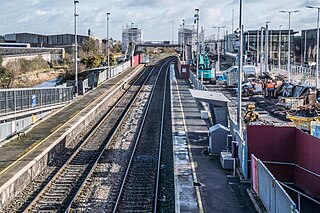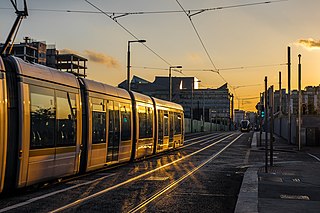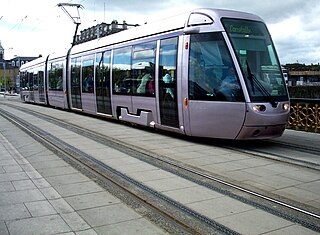Most of the transport system in Ireland is in public hands, either side of the Irish border. The Irish road network has evolved separately in the two jurisdictions into which Ireland is divided, while the Irish rail network was mostly created prior to the partition of Ireland.

The Dublin Area Rapid Transit system is an electrified commuter rail railway network serving the coastline and city of Dublin, Ireland. The service makes up the core of Dublin's suburban railway network, stretching from Greystones, County Wicklow, in the south to Howth and Malahide in north County Dublin. The DART serves 31 stations and consists of 53 route kilometres of electrified railway, and carries in the region of 20 million passengers per year. In a similar manner to the Berlin S-Bahn, the DART blends elements of a commuter rail service and a rapid transit system.

Córas Iompair Éireann, or CIÉ, is a statutory corporation of the Republic of Ireland, answerable to the Irish Government and responsible for most public transport within the Republic and jointly with its Northern Ireland counterpart, the Northern Ireland Transport Holding Company, for the railway service between Dublin and Belfast, via Drogheda, Dundalk, Newry and Portadown. The company is headquartered at Heuston Station, Dublin. It is a statutory corporation whose members are appointed by the Minister for Transport.

Rail transport in Ireland is provided by Iarnród Éireann in the Republic of Ireland and by Northern Ireland Railways in Northern Ireland.

Iarnród Éireann, or Irish Rail, is the operator of the national railway network of Ireland. Established on 2 February 1987, it is a subsidiary of Córas Iompair Éireann (CIÉ). It operates all internal InterCity, Commuter, DART and freight railway services in the Republic of Ireland, and, jointly with Northern Ireland Railways, the Enterprise service between Dublin and Belfast. In 2019, IÉ carried a record peak of 50 million passengers, up from 48 million in 2018.

Luas is a tram system in Dublin, Ireland. There are two main lines: the Green Line, which began operating on 30 June 2004, and the Red Line which opened on 26 September 2004. Since then, the red line has been extended and split into different branches further out of the city and the green line has been extended north and south as a single line. Since the northern extension of the green line in 2017, the two lines intersect in the city centre. The system now has 67 stops and 42.5 kilometres (26.4 mi) of revenue track, which in 2023 carried 48.2 million passengers, an increase of 24% compared to 2022.

Heuston Station, also known as Dublin Heuston, is one of Dublin's largest railway stations and links the capital with the south, southwest and west of Ireland. It is operated by Iarnród Éireann (IÉ), the national railway operator. It also houses the head office of its parent company, Córas Iompair Éireann (CIÉ). The station is named in honour of Seán Heuston, an executed leader of the 1916 Easter Rising, who had worked in the station's offices.

Transport 21 was an Irish infrastructure plan, announced in November 2005. Its aims were to greatly expand Ireland's transport network. A cost estimate of €34 billion was attached to the plan at the time.

The Green Line is one of the two lines of Dublin's Luas light rail system. The Green Line was formerly entirely in the south side of Dublin city. It mostly follows the route of the old Harcourt Street railway line, which was reserved for possible re-use when it closed in 1958. The Green Line allows for passengers to transfer at O’ Connell GPO and Marlborough to Luas Red Line services and also allows commuters to use Broombridge as an interchange station to reach outer suburbs such as Castleknock and Ongar as well as Iarnrod Éireann services.
MetroLink is a proposed metro line for the city of Dublin. It replaces an earlier proposal called Metro North which was first recommended in the then Irish Government's 2005 Transport 21 transport plan.
DART Underground, also known as the Interconnector or DART+ Tunnel, is a proposed mainline-rail tunnel in Dublin, Ireland. First proposed in 1972, as of 2021 it was not funded or scheduled. While the Greater Dublin Transport Strategy 2016-2035 included the DART Underground as a proposed National Transport Authority project, the tunnel was not included in the National Development Plan published in 2018 or DART+ expansion plans published in August 2020.

Broombridge is a railway station beside a Luas Tram stop serving Cabra, Dublin 7, Ireland. It lies on the southern bank of the Royal Canal at the western end of what had been Liffey Junction station on the erstwhile Midland Great Western Railway (MGWR). It takes its name from Broome Bridge, which crosses the canal, where William Rowan Hamilton developed the mathematical notion of quaternions. A plaque on the adjacent canal bridge and the name of the Luas Maintenance depot on site, Hamilton Depot, commemorates this.

InterCity is the brand name given to rail services operated by Iarnród Éireann that run between Dublin and other major cities in Ireland. InterCity branding is also used in other European countries by unaffiliated organizations.

This article deals with transport in the Greater Dublin Area centred on the city of Dublin in Ireland.

Docklands Station is a terminus railway station serving the Dublin Docklands area in Ireland. It is owned and operated by Iarnród Éireann and was part of the Irish Government's Transport 21 initiative.

Broadstone railway station was the Dublin terminus of the Midland Great Western Railway (MGWR), located in the Dublin suburb of Broadstone. The site also contained the MGWR railway works and a steam locomotive motive power depot. A Luas tram station opened at the front of the station in 2017.

Public transport in Ireland exists in many of the Ireland's urban areas and rural areas, and takes a number of forms. Bus transport is the main form of public transport and is common in all cities. The cities, Dublin, Belfast, Cork, Limerick and Galway all have their own suburban rail networks, although Dublin is the only to have its own tram line, in the form of the Luas. Ireland has a population of 5 million people.

St Stephen's Green is a stop on the Green Line of the Luas (tram) system in Dublin, Ireland. Originally opened in 2004, it was further developed as part of the Luas Cross City project between 2013 and 2017.

The TFI Leap Card is a contactless smart card for automated fare collection overseen by Transport for Ireland (TFI). It was introduced in the Greater Dublin area in 2011 for Luas, DART, Iarnród Éireann and Dublin Bus, but acceptance has significantly expanded, and it is now accepted in cities nationwide and on some longer distance commuter routes. Initially, Leap Cards offered only a pre-paid electronic wallet system for single-trip fares; since May 2014, it has also been possible to load it with weekly, monthly and annual subscriptions. In September 2017, there were over 2.5 million Leap Card users according to the National Transport Authority. The Leap Card is the result of many years' work by the Railway Procurement Agency and the National Transport Authority as part of the rollout of an integrated ticketing scheme for public transport in Dublin city. Fares are generally discounted compared to cash prices, and integrated ticketing is offered in the Dublin area via a flat fare system across all modes of transport. The minimum top-up for the card is currently €5, and it can be topped up via iPhone/Android App, at LUAS or DART ticketing machines, and in convenience stores offering Payzone services.

Transport Infrastructure Ireland is a state agency in Ireland, dealing with road and public transport infrastructure. The body was established in 2015 from a merger of the Railway Procurement Agency into the National Roads Authority, with the latter being assigned the new operational name of Transport Infrastructure Ireland (TII).

















